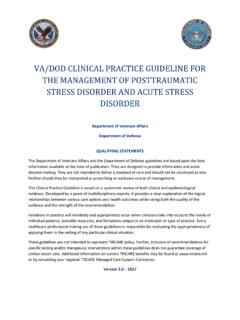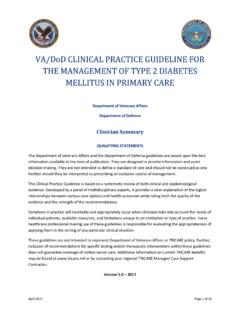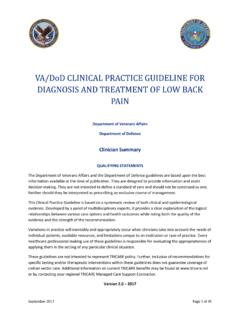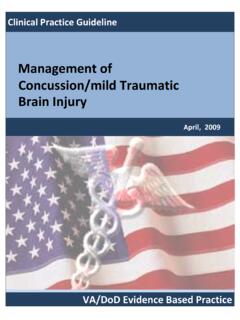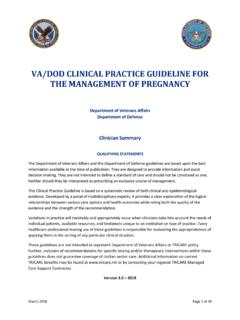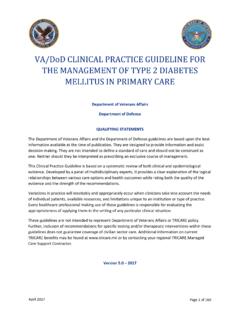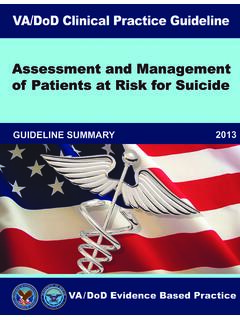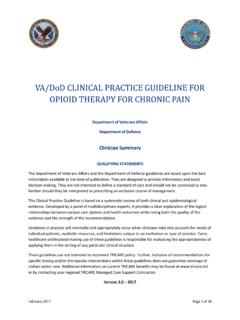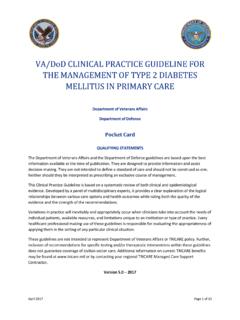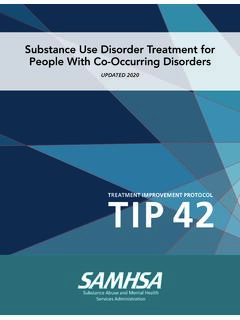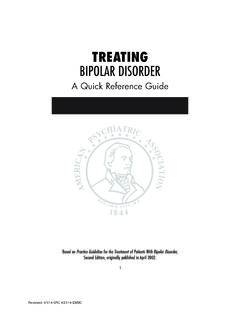Transcription of VA/DoD CLINICAL PRACTICE GUIDELINE FOR MANAGEMENT …
1 CLINICAL PRACTICE GUIDELINE MANAGEMENT of bipolar Disorder in Adults (BD) May, 2010 VA/DoD evidence based PracticeVA/DoD CLINICAL PRACTICE GUIDELINE FOR MANAGEMENT OF bipolar DISORDER IN ADULTS Department of Veterans Affairs Department of Defense Prepared by: The MANAGEMENT of bipolar Disorder Working Group With support from: The Office of Quality and Performance, VA, Washington, DC & Quality MANAGEMENT Division, United States Army MEDCOM QUALIFYING STATEMENTS The Department of Veterans Affairs (VA) and The Department of Defense (DoD) guidelines are based on the best information available at the time of publication.
2 They are designed to provide information and assist in decision-making. They are not intended to define a standard of care and should not be construed as one. Also, they should not be interpreted as prescribing an exclusive course of MANAGEMENT . Variations in PRACTICE will inevitably and appropriately occur when providers take into account the needs of individual patients, available resources, and limitations unique to an institution or type of PRACTICE . Every healthcare professional making use of these guidelines is responsible for evaluating the appropriateness of applying them in any particular CLINICAL situation.
3 Version 200 9 Table of Contents Page Introduction i GUIDELINE Update Working Group vi Algorithms and Annotations Module A: Acute manic or hypomania episode Module B: Acute Depressive Episode Module C: Maintenance Phase Module D: Pharmacotherapy Interventions Module E: Psychosocial Interventions Module F: Specific Recommendations for MANAGEMENT of Older Persons with BD Appendices Appendix A. GUIDELINE Development Process Appendix B. Assessment of Dangerousness to self or other Appendix C. PICO Questions Appendix D. Drug Tables Appendix E. Acronym List Appendix F. Participant List Appendix G. Bibliography VA/DoD CLINICAL PRACTICE GUIDELINE for MANAGEMENT of bipolar Disorder in Adults Introduction Page | i INTRODUCTION The CLINICAL PRACTICE GUIDELINE Update for the MANAGEMENT of bipolar disorders (BD) was developed under the auspices of the Veterans Health Administration (VHA) and the Department of Defense (DoD) pursuant to directives from the Department of Veterans Affairs (VA).
4 VHA and DoD define CLINICAL PRACTICE guidelines as: Recommendations for the performance or exclusion of specific procedures or services derived through a rigorous methodological approach that includes: Determination of appropriate criteria such as effectiveness, efficacy, population benefit, or patient satisfaction; and Literature review to determine the strength of the evidence in relation to these criteria. The VHA published the first CLINICAL PRACTICE GUIDELINE for the MANAGEMENT of Person with Psychosis in 2001. The original publication was aimed to assist medical care providers in all aspects of mental health care for a cluster of medical conditions characterized as mood disorders .
5 The overall expected outcomes of successful implementation of the GUIDELINE were to: Formulate an efficient and effective assessment of the patient's complaints Optimize the use of therapy to control symptoms Minimize preventable complications and morbidity Achieve satisfaction and positive attitudes regarding the MANAGEMENT of psychosis Promote recovery to the fullest extent possible The current publication aims to update the evidence base of the 2001 GUIDELINE . However, it is focused on MANAGEMENT of patients with a specific diagnosis of bipolar Disorder (BD). Other VA/DoD CLINICAL PRACTICE guidelines that have been developed since 2001 address other mental health conditions that were included in the original psychosis GUIDELINE .
6 (See www. ) Although diagnosis and treatment of BD illness is complex, effective treatment can lead to good outcomes for many patients. Primary care providers are in a key position to render early diagnosis and treatment of BD. This disease should always be considered as part of the differential diagnosis for depression or anxiety. Over the last few years, the care of severe mental illness has shifted from inpatient treatment to community based care. VHA has been rapidly moving from an inpatient to an outpatient model for the provision of general and mental health services. Primary care providers also provide continuing general medical care for patients with BD, understand patients' life circumstances and monitor their progress over time.
7 Significant advances in medications for BD, including the introduction of new therapies and the refinement of treatment protocols using older medications have occurred since the last GUIDELINE . There has also been increasing recognition of the contribution of psychological therapies to symptom relief, relapse prevention, optimal function, and quality of life. The goal of this 2009 update of VA/DoD GUIDELINE is to provide education and guidance to primary care clinicians, researchers and other health professionals as they treat patients with bipolar Disorder. Since bipolar depression is the most common presentation of bipolar disorder, some patients with BD are diagnosed and treated as unipolar depression.
8 Given the low detection and recognition rates of BD, it is essential that primary care and mental health practitioners have the required skills to assess patients with depression, their history, social circumstances and relationships, and the risk they may pose to themselves and to others. This is especially important in view of the fact that BD is associated with an increased suicide rate, a strong tendency for recurrence and high personal and social costs. The effective assessment of a patient, including risk assessment, and the subsequent coordination of the patient s care, is likely to improve diagnosis and lead to improved outcomes. VA/DoD CLINICAL PRACTICE GUIDELINE for MANAGEMENT of bipolar Disorder in Adults Introduction Page | ii BURDEN OF DISEASE - bipolar DISORDER bipolar disorder (BD) is a major cause of impaired quality of life, reduced productivity, and increased mortality.
9 Social difficulties are common ( , social stigma, loss of employment, marital break-up). Associated problems, such as anxiety symptoms and substance misuse, may cause further disability. bipolar disorder is an episodic, potentially life-long, disabling disorder. Diagnostic features include periods of acute mania, hypomania and depression. bipolar disorder is characterized by periods of abnormally elevated mood or irritability, which may alternate with periods of depressed mood or a mix of symptoms. These episodes are distressing and often interfere with occupational or educational functioning, social activities and relationships. Most patients with bipolar disorder can achieve substantial stabilization of their mood swings and related symptoms with proper (continuous) treatment.
10 Because bipolar disorder is a recurrent illness, long-term preventive treatment is strongly recommended and almost always indicated. A strategy that combines medication and psychosocial treatment is optimal for managing the disorder over time. The etiology of the disorder is uncertain but genetic and biological factors are important. The environmental and lifestyle features can have an impact on severity and course of illness. bipolar disorder is often comorbid with a range of other mental disorders (for example, substance misuse and anxiety disorders ) and this has significant implications for both the course of the disorder and its treatment. Individuals with bipolar disorder are currently treated in a range of VHA/DoD settings, including primary-care services, general mental health services and specialist secondary-care mental health services.
